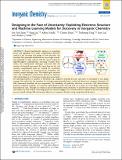DesDesigning in the Face of Uncertainty: Exploiting Electronic Structure and Machine Learning Models for Discovery in Inorganic Chemistry
Author(s)
Janet, Jon Paul; Liu, Fang; Nandy, Aditya; Duan, Chenru; Yang, Tzuhsiung; Lin, Sean; Kulik, Heather Janine; ... Show more Show less
DownloadPublished version (2.785Mb)
Terms of use
Metadata
Show full item recordAbstract
Recent transformative advances in computing power and algorithms have made computational chemistry central to the discovery and design of new molecules and materials. First-principles simulations are increasingly accurate and applicable to large systems with the speed needed for high-throughput computational screening. Despite these strides, the combinatorial challenges associated with the vastness of chemical space mean that more than just fast and accurate computational tools are needed for accelerated chemical discovery. In transition-metal chemistry and catalysis, unique challenges arise. The variable spin, oxidation state, and coordination environments favored by elements with well-localized d or f electrons provide great opportunity for tailoring properties in catalytic or functional (e.g., magnetic) materials but also add layers of uncertainty to any design strategy. We outline five key mandates for realizing computationally driven accelerated discovery in inorganic chemistry: (i) fully automated simulation of new compounds, (ii) knowledge of prediction sensitivity or accuracy, (iii) faster-than-fast property prediction methods, (iv) maps for rapid chemical space traversal, and (v) a means to reveal design rules on the kilocompound scale. Through case studies in open-shell transition-metal chemistry, we describe how advances in methodology and software in each of these areas bring about new chemical insights. We conclude with our outlook on the next steps in this process toward realizing fully autonomous discovery in inorganic chemistry using computational chemistry.
Date issued
2019-03Department
Massachusetts Institute of Technology. Department of Chemical Engineering; Massachusetts Institute of Technology. Department of Chemistry; Massachusetts Institute of Technology. Department of Materials Science and EngineeringJournal
Inorganic Chemistry
Publisher
American Chemical Society (ACS)
Citation
Janet, Jon Paul et al. "Designing in the Face of Uncertainty: Exploiting Electronic Structure and Machine Learning Models for Discovery in Inorganic Chemistry." Inorganic Chemistry 58, 16 (March 2019): 10592–10606. © 2019 American Chemical Society
Version: Final published version
ISSN
0020-1669
1520-510X